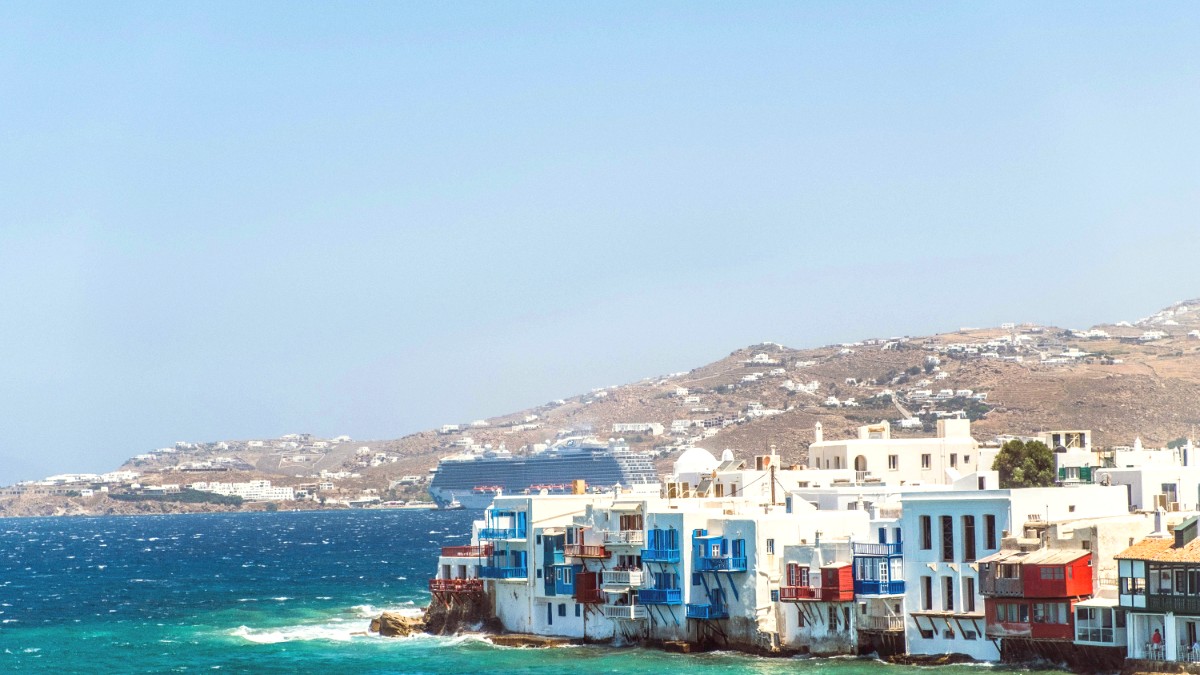
Cyclades, Greece
Mykonos delivers these scenes and more. This island in the heart of the Cyclades is a place for an experience that many different travelers enjoy. From its legendary beach clubs to quiet, untouched coves, Mykonos has a mix of excitement and relaxation. The island’s energy is palpable, yet moments of calm are always nearby. Find a spot to watch the sun set, enjoy fresh seafood by the sea, or simply wander through the charming streets of Mykonos Town.
Mykonos has a long history of welcoming visitors. It transformed into a popular destination decades ago and continues to draw people from around the globe. This blend of international flair and traditional Greek island character creates a distinct atmosphere. Each visit can uncover something new, whether a secluded beach, a family-run taverna, or a new viewpoint for the island’s famous sunsets. Mykonos has a reputation for hospitality; guests feel welcome and well cared for. The island’s appeal shows its presentation of diverse experiences. Mykonos is a setting for a travel experience tailored to personal preference. You can choose to spend your days on a lively beach, dancing to global DJ sets, or exploring ancient ruins on a nearby island. Mykonos is the setting; you shape the adventure. The island’s beauty is a constant draw. The clear blue waters, the golden sandy beaches, and the iconic white houses with their blue or red trim create a postcard-perfect scene at every turn. Even with its popularity, Mykonos keeps its traditional Cycladic aesthetic, which is part of its allure. The light here is notably bright, making every photograph a memory. Sunsets over the Aegean Sea are legendary, painting the sky with colors that linger long after the sun dips below the horizon. These natural displays show a quiet contrast to the island's bustling nightlife, with moments of reflection. Visitors describe Mykonos as an island that encourages freedom. Move at your own pace, choose your own adventures, and discover what makes this Greek destination so special. Its well-developed tourism infrastructure has straightforward access to services and comforts, yet local charm and tradition remain. This guide assists your navigation of the options, from booking your stay to exploring the island’s many facets. Prepare to create memories on Mykonos.
The island’s capital, Mykonos Town (Chora), sits on the west coast, facing the island of Delos. The town’s location and its natural harbor have historically made it a port. Its labyrinthine street plan, a defensive design against pirates, is part of its charm today.
This close proximity to other islands means Mykonos is an ideal base for day trips and further exploration of the Cyclades, for swimming, sailing, and a connection to the maritime heritage of the region.
Mykonos is a fascinating history, intertwined with Greek mythology and ancient civilizations. According to myth, Mykonos formed from the petrified bodies of giants defeated by Hercules. The island's name itself is linked to Mykons, a grandson of Apollo. While these stories are part of its mystique, the island’s true historical importance has a strong connection to its neighbor, Delos.
Delos, an UNESCO World Heritage site, is one of Greece's most important archaeological sites. Ancient Greeks believed it to be the birthplace of Apollo and Artemis; it was a sacred sanctuary. During ancient times, Delos was a major religious and commercial center. Mykonos, just a short distance away, served as a supply island for Delos. Its strategic position in the Aegean Sea made it a frequent stop for traders and sailors. Evidence of early settlements on Mykonos dates back to the Neolithic period, around 3000 BC.
Early settlements; supply island for Delos, a major religious and commercial hub.
Continued connection to Delos's prosperity and decline.
Under various rulers; Venetian influence visible in Little Venice.
Labyrinthine streets designed to confuse intruders.
From agricultural island to global tourist destination; boosted by celebrity visits.
The island’s unique architectural style, characterized by whitewashed cubic houses and narrow, labyrinthine alleys, developed partly as a defense mechanism against pirates during the Ottoman rule. These twisting streets were designed to confuse intruders, it was harder for them to navigate and locals could defend their homes effectively. This practical design is a significant part of the island's charm and identity.
In more recent history, Mykonos was a poor agricultural and fishing island until the mid-20th century. It transformed into a global tourist destination starting in the 1930s when artists, intellectuals, and then the international jet set discovered its beauty and relaxed atmosphere.
Jackie Kennedy Onassis's visits in the 1960s cemented its status as a glamorous destination. The island embraced tourism, adapting its infrastructure and seeking to preserve its Cycladic character. This balance between modern tourism and historical roots shapes Mykonos today. The windmills, once used for grinding grain, are now iconic symbols of the island’s past and its enduring connection to the forces of nature.
Its journey from a humble island to a world-renowned tourist hub reflects a continuous evolution while keeping its unique Cycladic identity.
Mykonos is a dynamic blend of high-energy entertainment, stunning natural beauty, and historical depth. This Cycladic island has earned its reputation as a premier global destination, drawing visitors who look for both lively social scenes and serene escapes.
Mykonos has a Mediterranean climate. Summers are hot and dry. Strong northerly "Meltemi" winds often offer a break from the heat.
Explore Little Venice, the Windmills, and Panagia Paraportiani Church. Delos Island, an UNESCO World Heritage site, accessible by boat, shows a glimpse into Greece's rich past.
Mykonos is a party hub, with world-renowned beach clubs and bars. Water sports, boat tours, and shopping are popular. Enjoy fresh seafood and local specialties.
Mykonos has a public bus system connecting Mykonos Town to major beaches. Taxis are limited. Scooter, ATV, and car rentals are popular options for exploring the island independently. Water taxis connect some southern beaches. Mykonos is one of Greece's more expensive destinations, especially in high season. Booking well in advance is suggested.